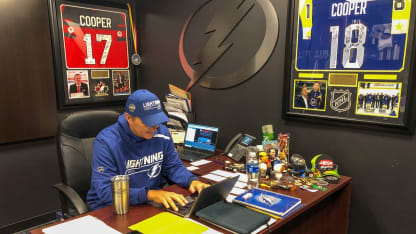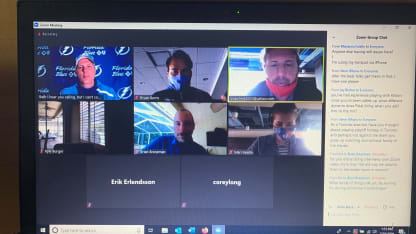Before I could even finish the question, a technical glitch interrupted.
During post-practice interviews following a training camp session earlier this week, I wanted to ask Tampa Bay Lightning head coach Jon Cooper his thoughts on the new protocols media were now required to follow to cover the team. Namely, whether he enjoyed conducting his media sessions over Zoom video calls rather than the traditional, pre-pandemic way of forming a semi-circle a couple feet around him in an auxiliary locker room, a practice commonly referred to as a scrum.
The new normal: Socially-distanced interviews
The Bolts - and the media - are having to adjust to virtual scrums conducted via Zoom

In a Covid world, media are not allowed in locker rooms. Heck, we're not even allowed close to the ice. Instead, media are sectioned off in the last five rows of the promenade (lower) level at AMALIE Arena, required to wear masks while inside the arena and told to socially distancing themselves from other reporters.
For interviews, media log into a Zoom meeting room. Inside the Lightning locker room corridor, in one of the unused performer rooms, a computer with a webcam is set up on a table in front of a backdrop. One by one, Lightning players and coaches are ushered into the room to sit in front of the video camera and answer questions from the media, who are stationed across the ice on the AMALIE Arena concourse between sections 118-120.
Each reporter has their own video feed from their laptop or phone which the player or coach can see displayed on their end of the Zoom call. Media submit their questions via the chat feature. Lightning senior director of broadcasting, programming and communications Brian Breseman facilitates the calls from a remote location, reading the questions as they come in then calling on the reporter to ask their questions once it's their turn.

It was in this scenario where I submitted my question to Cooper. I suspected the convenience might make Zoom calls more palatable for him, but Cooper has a friendly rapport with the media where his quick wit and good-natured snarkiness can produce some humorous interactions that get lost in the lag time of a video conference.
I asked my question and waited.
And waited.
And waited some more.
"Okay, so there's a perfect example because I understood like two words you said, you froze the whole time," Cooper said.
I think I had my answer.
Cooper turned to Trevor Van Knotsenburg, the Lightning's senior manager of communications and the p.r. person among the player-access staff allowed inside the locker room. Van Knotsenburg turns on the camera inside the player media room each day and is responsible for bringing the players and the head coach to the new setup.
"Trevor, could you imagine if that was actually real, (Burnsie) would be like, 'So Coop, do you believe…' and then nothing," Cooper asks, mimicking the way my face froze on his end as if I were doing it in person. "So I don't actually know what you said. What did you say?"
I ask again, praying the connection holds up this time.
"I'll have to do a few more of these," Cooper says, "I don't know if I like them more. They're more convenient, I'll tell you that."
Being the head coach, Cooper can do the Zoom calls from the comfort of his locker room office, although he's also popped into the players media room to conduct them too.
"I don't have to get out of my chair. If I was (former Tampa Bay Rays and current Los Angeles Angels manager) Joe Maddon, all I would be missing is a glass of wine," Cooper jokes about his coaching buddy. "I like the personal interaction (of scrums). You see people. You read body language. There's a little bit more of a back-and-forth relationship when that goes on. No, I can't sit here and say I like Zoom better."
Cooper might not enjoy the Zoom calls as much as the traditional interview situation, but he certainly makes the best of them. On the second call, he figured out how to change the names on each person's box and has found particular delight in messing with Breseman's box. And he's learned he can mute people too, which he jokes about doing to certain reporters when they ask too many questions but hasn't yet.
Instead, twice this week while giving an answer in camp, his computer has decided to mute automatically.
"That's just muting itself," Cooper said perplexed after the second time it happened. "Maybe even the computer's like, 'Geez, your answers are way too long. Shut up.'"
So put Cooper down for a 'no' on the Zoom calls, but what about the players? I've often wondered how they feel about media cramping their space inside the locker room, hovering over them while they attempt to take off their gear from practice or a game. Maybe they'll enjoy the added level of privacy with having their locker room closed off to outsiders.
"It's a little bit quicker, easier, you come in and out over the Zoom calls," Lightning center Anthony Cirelli said. "But, yeah, it's something we've got to deal with right now. If this is what we have to do, it works. You come into your little media scrum here, and you're done. The other way is a little more interactive, you're a little closer and in your face, I guess."
Seems like there's plusses and minuses to the Zoom calls, just as there's pros and cons to the scrum.
Behind the scenes of today’s media Zoom call with Pally. 👋 pic.twitter.com/vVVhoQX684
— Tampa Bay Lightning (@TBLightning) July 15, 2020
"I think either way is fine as long as you get the time to do it," Blake Coleman said. "It's different, but this is kind of how we did things in college, so it's not completely foreign to me. It's just different. Everything's different. A little bit of a new world now. I don't think one's necessarily better than the other, but it's just a change for the time being, just got to get familiar with."
So, by my unofficial tally Cooper prefers the scrums but has adapted well to the Zooms. The players don't seem to care too much either way.
For the media, however, Zoom calls aren't ideal. There are always technical issues like the one I experienced. Sometimes another reporter will accidentally leave their mic unmuted when they're not talking, and the mic picks up their background noise and makes it hard to hear an answer. Other times a reporter will start to ask a question and not realize their mic is still muted.
Also, it's hard to write creative stories when every reporter's getting the same players and hearing the same answers. Part of what makes the traditional interview situation so preferable from the media perspective is you have the opportunity to sidle up to a player away from other reporters and ask questions for a story idea nobody else is writing about. You can usually get more thoughtful answers from a player this way when they don't have 20 microphones and cameras invading their space. It's a more comfortable situation for both reporter and player.
The Zoom calls aren't going anywhere anytime soon. Media won't be allowed inside the bubbles when the Stanley Cup Playoffs get underway. All post-game interviews will be conducted via Zoom, just like in training camp. A reporter Toronto will have the same access as, say, a reporter in Tampa.
Which will lend itself to more technical glitches.
But also, more amusing interactions like the one Cooper and I shared earlier this week.


















